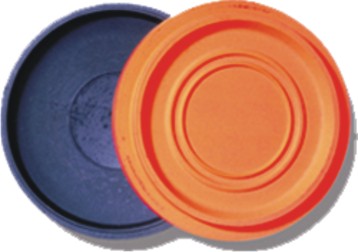American Trap (ATA – Amateur Trapshooting Association) A discipline in Clay Target Shooting where a single trap is used to release a clay. The squad of five shooters stand in a line behind the trap and each take it in turn to shoot at a target released from the trap. Each shooter will eventually shoot at 5 targets from each stand.
Battue (Plate) Special type of flat target used in all forms of sporting English Sporting (known as Sporting Clays in the USA), 5-Stand Sporting, Sportrap and FITASC Sporting
Bead Generally a small white, round object which is situated on the very end of the barrel on top of the rib. It is used as almost a subconscious ‘sight’ for the shooter. Sometimes there is another bead in the middle of the rib as an additional sight to help you line up the front bead and your eye.
Broken The state of the gun when not in use, i.e. the chambers are visibly empty and the barrels are not closed up to the stock. Guns should always be in this condition unless one is on the shooting-stand ready to shoot.
Cartridge The ammunition used to break the clay. A cartridge contains a primer to ignite the shot powder which propels the lead shot out of the gun. Cartridges vary in their weight (in Clay Target Shooting we use from 24gm to 36gm) and in their shot size (from 2mm to 2.5mm diameter).
Choke The narrowing or constriction at the end of the barrel to either widen or narrow the pattern of shot as it leaves the gun.
Classification All shooters who participate in National and Provincial Championships will get classified according to their ability. Classes are: A, B, and C. Further categories are: Ladies, Veterans, Juniors and Colts. The shooter’s scores are used to provide calculations on which their classification is based.
Clay Target The round dish shaped target made of pitch and lime varies in sizes from 60mm through to 110mm. Varies in colour – can be black, orange, white or pink.
Double When a shooter must shoot at two targets (i.e. one shot at each target). They can be sent out simultaneously (two targets released from two different traps at the same time – one on each trap), following pair (i.e. one after the other along the same trajectory) or on report (the second target is thrown immediately the first shot has been fired at the first target). Two targets can also be loaded on one trap that has one (or two) ‘arms’ and thrown as a simultaneous pair – this would be from a manual trap.
DTL Down-The-Line Trap – a variation on ATA Trap. Scoring is 3 points for a kill, 2 for a second barrel kill and zero for lost. The angles of the targets are slightly different from ATA Trap.
Ear Defenders It is important to protect the ears from damage from the loudness of the cartridge being fired. Ear protection takes the form of either sponge plugs/plastic plugs which are inserted into the ear, or earphones which cover the whole ear. Ear protection is compulsory in all shooting disciplines.
English Sporting A discipline which uses sporting clays (normals, minis, battues, rabbits, super-mins) where the shooter can call for the target with the shotgun already in the shoulder. This event is generally shot over 10 stands of 10 targets on each stand. Each stand will have two targets thrown in a pair. The shooter will shoot at five pairs, each pair being the same combination. Sometimes stands can have 3 or 4 pairs – it depends upon the numbers of shooters participating. The more stands, the more variety of pairs!
Etiquette Shooters respect for fellow shooters. Shooters may not touch another person’s firearm unless given permission by the owner. Guns are carried broken at all times. Guns are not pointed at anything except targets or down range. Shooters must wait until the last person has finished shooting before moving off the range.
F.I.T.A.S.C. Federation Internationale de Tir Aux Armes Sportives de Chasse – the international governing body for F.I.T.A.S.C. Sporting and F.I.T.A.S.C. Universal Trench.
F.I.T.A.S.C. Universal Trench See “Trench”.
F.I.T.A.S.C. Sporting A type of sporting discipline where targets are shot in rounds of 25 or 20 over 3 or 4 stands. Each stand will have a different sequence of singles and doubles (pairs). The shooter must not mount the gun to the shoulder until the target has been called for and is visible to the shooter. The gun must remain at 25cm below the shoulder until the target can be seen.
Glasses It is compulsory for all shooters to wear eye protection from stray fragments of clay or burn powder. Good glasses will also help the shooter to see clays more easily by cutting down glare from the sun, or brightening up a dull day.
Gun Fit Very important for all shooters to have their gun “fitted”to them. It ensures that the sight picture the shooter sees is perfectly straight and that the gun does not ‘kick’ when used.
Kill/Lost When a target is hit (i.e. more than a visible piece is seen to come off the clay in flight) it is announced as a “kill”. Americans also use the word “dead”. If, when a target has been fired at and missed, it is referred to as “lost” or “zero”.
Lead Or sometimes referred to as “forward allowance”- the amount of space which you shoot in front/ below/ on top of a clay in order to break it. Remember that you shoot where the clay is going and not where it is.
No-Target Often referred to as No-Bird – is when a target comes out of the trap broken; is the wrong trajectory or when the shooter commits an offence.
Minimum Qualifying Score The score required in order to qualify to take up a Quota Place in the Olympics.
NSSA Skeet A variation on English Skeet – the targets are slight faster (but not as fast as Olympic Skeet) and instead of shooting a pair of targets on station four, the “duck” station is used (station 8).
Olympic Skeet A form of skeet where the targets are faster, the gun must rest on the crest of the hip-bone until the target appears (only then can you mount the gun to the shoulder and fire) and you have a possible delay of anything between 0 and 3 seconds between the time you call Pull! until the target appears.
Olympic Trap See “Trench”.
Olympic Double-Trap See “Trench”.
On Report In all forms of sporting clay disciplines, this term is used when the shooter first shoots at one target and then on the firing of the first shot, the next target is released.
Over & Under A shotgun where one barrel sits on top of the other, joined together by “side ribs.”
Pull! The command the shooter issues when he is ready for the clay to be released. Some shooters call “ready”, others just grunt! Some Americans call “hup”!
Quota Place A place in the Olympics earned by a shooter for his country.
Rafale In FITASC Sporting, the term used for two targets sent from an automatic trap one immediately after the other – known in English as a ‘following pair’.
Range The place where shooting takes place.
Rib The flat piece of metal on top of the barrels. It is non-reflective so that there is no glare to distract the shooter when mounting the shotgun to shoot.
Rocket Special type of thick, heavy target used in all forms of sporting clay disciplines.
Round Generally 25 targets are shot per round. Olympic Double-Trap is shot in rounds of 30.
Scoring All scoring in Clay Target Shooting (with the exception of what is known as Down The Line) is 1 point per target hit. All scores are listed out of 25 and then out of the total targets for the competition. A competition is generally either out of 100 or 200 targets, therefore listed within that result will be either four scores out of 25, or eight scores out of 25. Olympic disciplines are scored out of 125 for Olympic Skeet and Olympic Trap and Olympic Double-Trap is 150 targets.
Semi-Automatic Shotgun This type of shotgun is ideal for someone who shoots a lot; for someone of a slight build or for a young person. The reason being is that it delivers very little recoil. It is a single-barreled shotgun where you can insert two cartridges in the breech. The recoil from the firing of the first cartridge loads the second cartridge. It is very important for the shooter to adhere to the safe carrying of this type of shotgun. The semi-auto should be carried with the barrel pointing upwards, breech open and facing forwards and the shotgun unloaded otherwise it can be safely carried unloaded in a normal gun bag.
Shooting Vest Normally a sleeveless jacket with pockets to hold cartridges and a leather patch on the shoulder from which the shooter will shoot. The leather patch absorbs some recoil and allows the gun to slip into the shoulder easily.
Shotgun A shotgun is the firearm used in Clay Target Shooting, It is a smooth-bore weapon. Please note that we do not use RIFLES – a rifle is a very different firearm. The difference is that a shotgun uses a cartridge filled with lead pellets, whereas a rifle uses a single projectile. Further, the barrel of a rifle is “spiralled’ so that the projectile (bullet) is sent spinning as it travels through the barrel.
Side Ribs Metal pieces which hold barrels together.
Side-by-Side A shotgun where the barrels (two of them) sit side by side is not ideal for competitive Clay Target Shooting, but can be used for non-serious shooting or field shooting.
Single When a shooter shoots at one clay only.
Sporting Clays Different types of targets are used to simulate live game shooting. Therefore, virtually any trajectory, speed or angle can be used. The clay types are normal, mini (called a ‘midi’ in Europe), super-mini, battue (plate), rocket, rabbit.
Squad Refers to the group of shooters who shoot a round of clays or a competition.
Stand The position from where the shooter will fire his shots.
Straight 25 When a shooter scores 25 out of 25 it is referred to as a “Straight 25”. Straight 50’s, 75’s and 100’s are also recorded and members can purchase badges to sew onto their shooting jackets which reflect their achievement.
Swing Used to refer to the movement of the gun when the shooter shoots. It is important to have a smooth swing (as in golf.) The trigger should be pulled during the swing and not at the end of the swing.
Trap The machine which launches the clay into the air.
Trench There are three disciplines in this group which use a combination of 15 traps, 5 traps or 2 traps. All traps are concreted into a “trench” situated in front of the shooters. Olympic Trap and Olympic Double-Trap are in this group. The other discipline is F.I.T.A.S.C Universal Trench which uses 5 traps out of the 15.
ISSF International Shooting Sport Federation – the international shooting union which governs Olympic shooting.
Umpires The Umpire in Clay Target Shooting is responsible for judging whether the targets are “killed” or “lost” and for applying the rules of the relevant shooting discipline. Rules do vary between each discipline, so it is encumbent upon each shooter to know his rules. Umpires are called “judges” in the ISSF. Also called ‘referees’ in the American disciplines.




